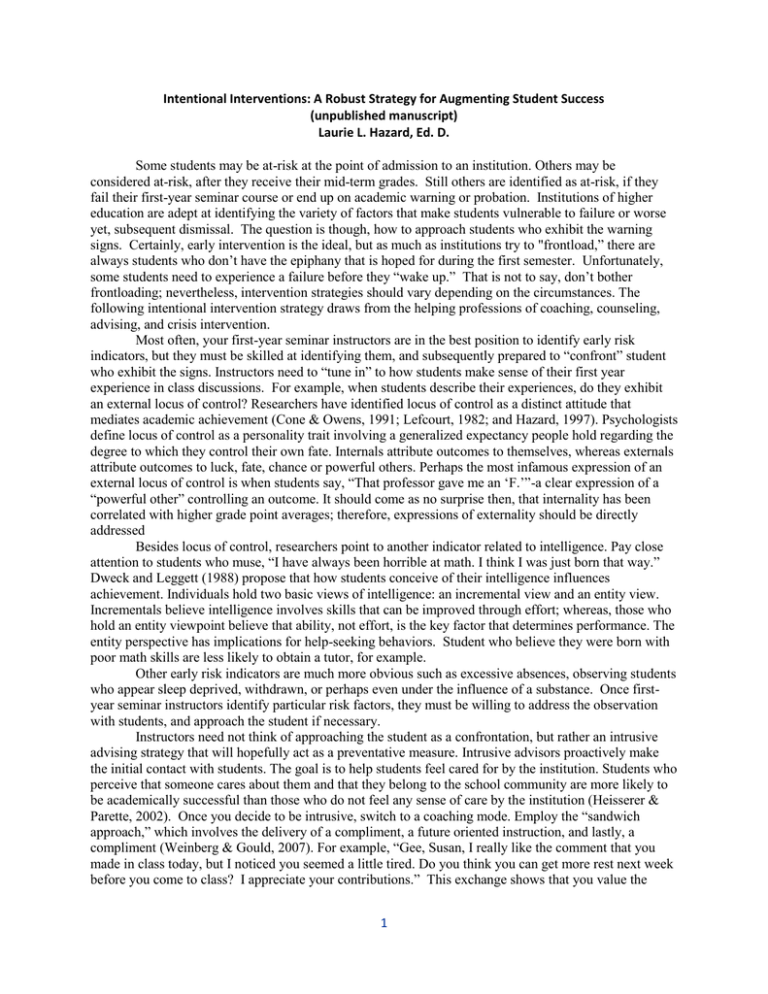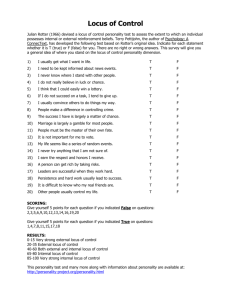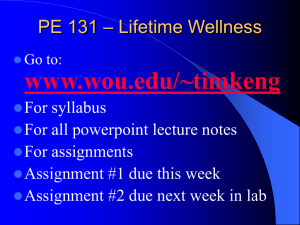Intentional Interventions: A Robust Strategy for Augmenting Student
advertisement

Intentional Interventions: A Robust Strategy for Augmenting Student Success (unpublished manuscript) Laurie L. Hazard, Ed. D. Some students may be at-risk at the point of admission to an institution. Others may be considered at-risk, after they receive their mid-term grades. Still others are identified as at-risk, if they fail their first-year seminar course or end up on academic warning or probation. Institutions of higher education are adept at identifying the variety of factors that make students vulnerable to failure or worse yet, subsequent dismissal. The question is though, how to approach students who exhibit the warning signs. Certainly, early intervention is the ideal, but as much as institutions try to "frontload,” there are always students who don’t have the epiphany that is hoped for during the first semester. Unfortunately, some students need to experience a failure before they “wake up.” That is not to say, don’t bother frontloading; nevertheless, intervention strategies should vary depending on the circumstances. The following intentional intervention strategy draws from the helping professions of coaching, counseling, advising, and crisis intervention. Most often, your first-year seminar instructors are in the best position to identify early risk indicators, but they must be skilled at identifying them, and subsequently prepared to “confront” student who exhibit the signs. Instructors need to “tune in” to how students make sense of their first year experience in class discussions. For example, when students describe their experiences, do they exhibit an external locus of control? Researchers have identified locus of control as a distinct attitude that mediates academic achievement (Cone & Owens, 1991; Lefcourt, 1982; and Hazard, 1997). Psychologists define locus of control as a personality trait involving a generalized expectancy people hold regarding the degree to which they control their own fate. Internals attribute outcomes to themselves, whereas externals attribute outcomes to luck, fate, chance or powerful others. Perhaps the most infamous expression of an external locus of control is when students say, “That professor gave me an ‘F.’”-a clear expression of a “powerful other” controlling an outcome. It should come as no surprise then, that internality has been correlated with higher grade point averages; therefore, expressions of externality should be directly addressed Besides locus of control, researchers point to another indicator related to intelligence. Pay close attention to students who muse, “I have always been horrible at math. I think I was just born that way.” Dweck and Leggett (1988) propose that how students conceive of their intelligence influences achievement. Individuals hold two basic views of intelligence: an incremental view and an entity view. Incrementals believe intelligence involves skills that can be improved through effort; whereas, those who hold an entity viewpoint believe that ability, not effort, is the key factor that determines performance. The entity perspective has implications for help-seeking behaviors. Student who believe they were born with poor math skills are less likely to obtain a tutor, for example. Other early risk indicators are much more obvious such as excessive absences, observing students who appear sleep deprived, withdrawn, or perhaps even under the influence of a substance. Once firstyear seminar instructors identify particular risk factors, they must be willing to address the observation with students, and approach the student if necessary. Instructors need not think of approaching the student as a confrontation, but rather an intrusive advising strategy that will hopefully act as a preventative measure. Intrusive advisors proactively make the initial contact with students. The goal is to help students feel cared for by the institution. Students who perceive that someone cares about them and that they belong to the school community are more likely to be academically successful than those who do not feel any sense of care by the institution (Heisserer & Parette, 2002). Once you decide to be intrusive, switch to a coaching mode. Employ the “sandwich approach,” which involves the delivery of a compliment, a future oriented instruction, and lastly, a compliment (Weinberg & Gould, 2007). For example, “Gee, Susan, I really like the comment that you made in class today, but I noticed you seemed a little tired. Do you think you can get more rest next week before you come to class? I appreciate your contributions.” This exchange shows that you value the 1 relationship with the student and provides an opening for them to share what might be going on. If they “bite,” probe and intrude-it may be the only opportunity to find out if the student needs help. On the other hand, if the student resists your efforts, they simply may not be ready. Unfortunately, some students just aren’t ready until second semester after the experience of failing. Crisis intervention tools are useful when students have received some type of concrete information about their academic progress. For some students it could be as small as a failed quiz grade; for others, it might have to be a failed semester or impending dismissal. In these cases, the personnel implementing the strategy might be a counselor, an advisor, the first-year seminar instructor or a learning specialist: Establishing A Positive Relationship The goal is to let the student know you care about their progress: “I really want to see you be successful. My role is to assist you with your academic, social, emotional, and intellectual transition. Let’s use those four areas to guide our conversation. Now that you have received concrete information about your midterm grades, I’d like some feedback from you about how you are doing with your academic adjustment………” Understanding and Clarifying the Problem This part is crucial. DON’T look at the mid-term grades, see a C- and simply refer the student to tutoring. DO peel back the onion layers” to determine the nature and cause of the low grade. For instance, is the C- a resulting from procrastination and motivational issues? Poor reading comprehension skills and/or deficiency in tacit knowledge? Missing class because of sleep problems, alcohol issues, or general health and wellness concerns? Inability to focus because of Interpersonal issues (intimate relationships, roommates, family)? Challenges with the pedagogical techniques of the instructor? Feeling marginalized because of race, culture, religion and/or sexual orientation? Assessing “Lethality” Although academic failure may not be considered lethal, it still constitutes a crisis for the student. Once the problem is clarified, in partnership with the student, find out what they really want to get out of the semester and what the chances are for him or her to “turn things” around. Here’s where you’ll utilize success counseling techniques. What is the student doing to get what he or she wants out of the semester? Is it working? What needs to change? Assessing and Mobilizing Resources What personnel from the institution does the student need assistance from in order to be successful? Is tutoring necessary? Does the student need personal counseling? Does the student need to speak with a Resident Assistant? Do they feel supported by the institution, their parents, and friends? What do they think they need to be successful? Formulating A Plan Often in this stage, one or more referrals may have been necessary. Follow up once you have made a referral. For instance, if you do determine that the student needs to see a tutor, counselor, faculty member, and/or advisor, give them a specific, agreed upon deadline to obtain the services. Once the deadline has passed, follow up with both the student and campus resources to see if the student followed through. If students don’t follow through, be intrusive. Find out what prevented them from doing so. Scheduling issues? Work? Lack of motivation? Peer pressure? When students do follow through, find out how their session with the tutor, advisor, and/or counselor went. Was it effective? Did they get what they needed? The final step, though not a formal part of the crisis intervention model, is to assess the students’ self-efficacy. That is to say, does the student believe that he or she possesses the abilities, skills, and 2 motivation to follow through with the plan? If not, assist the student in ways to effectively create accountability. Would it be helpful if you checked back in with them? How often? In what ways? These intervention strategies drawn from coaching, counseling, advising, and crisis intervention provide techniques for effectively approaching at-risk students in ways that can help them achieve academic success. Moving away from the idea of confronting students, toward partnering with them in an intrusive advising relationship, will allow institutions to support students in their process of goal setting, self-regulation, and increased autonomy. Meeting students at their level of readiness will ultimately lead to greater self-awareness. 3 References Comer, R.J. (2007) Abnormal Psychology. New York: Worth Publishers. Cone, A.L., & Owens, S.K. (1991) Academic Locus of Control Enhancement in a Freshman Study Skills and College Adjustment Course. Psychological Reports, 68, 1211-1217 Hazard, Laurie. (1997). The Effect of Locus of Control and Attitudes Toward Intelligence On Study Habits of College Students. Michigan: UMI. Heisserer, D.L. & Parette. P. (2002 March). Advising at-risk students in college and university settings. College Student Journal, 36(1), 69-84. Retrieved April 1, 2007 from EBSCOhost database. Lefcourt, H.M. (Ed.). (1984). Research With The Locus of Control Construct. New York: Academic Press, Inc. Weinberg, R.S., & Gould D. (2007). Foundations of Sport and Exercise Psychology. Illinois: Edward Brothers. 4 5




